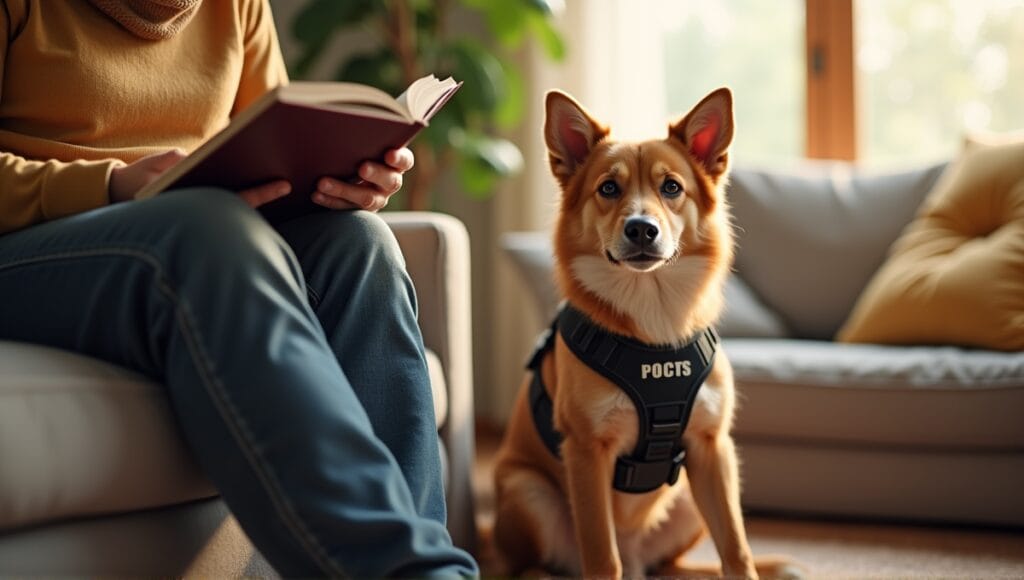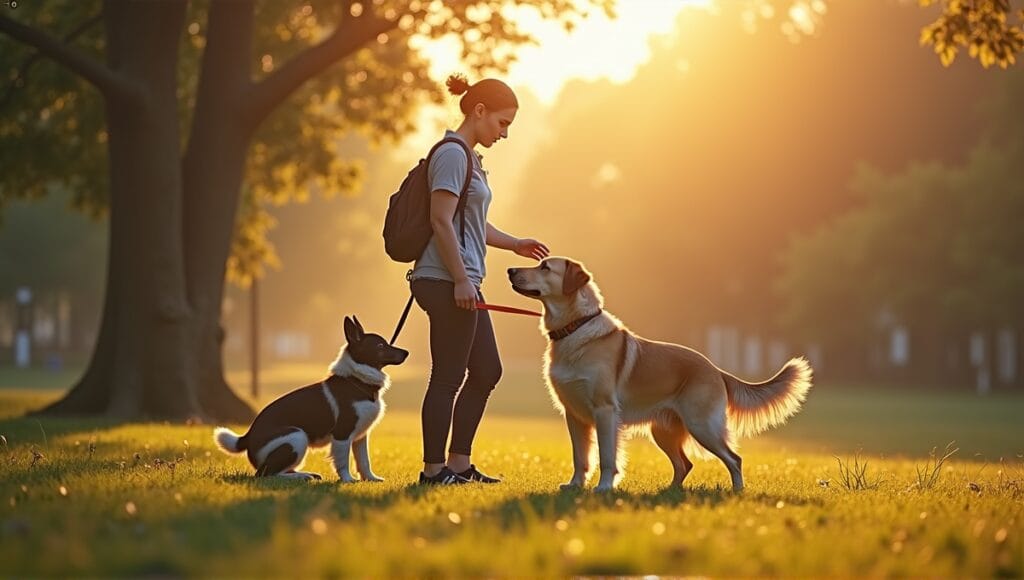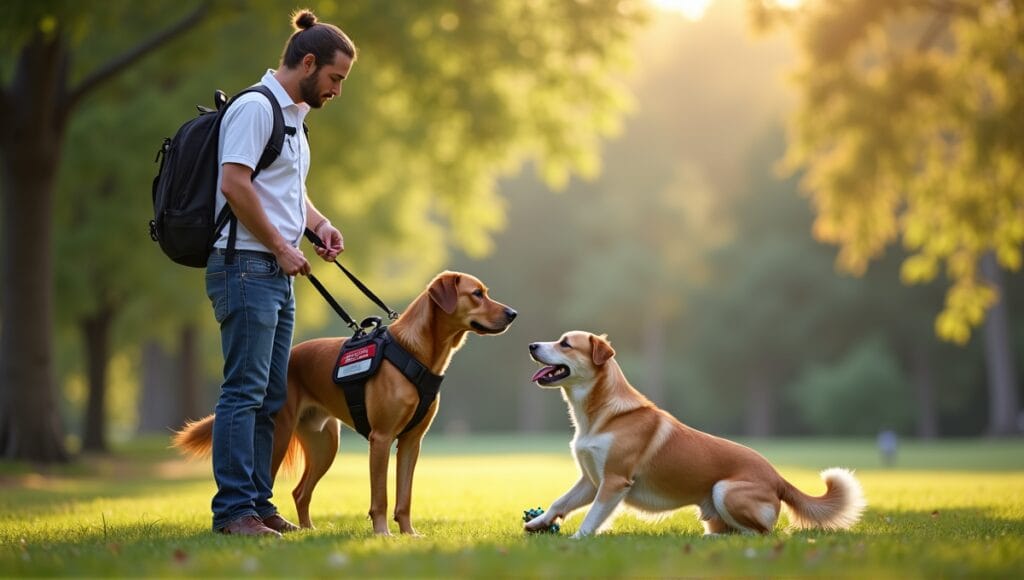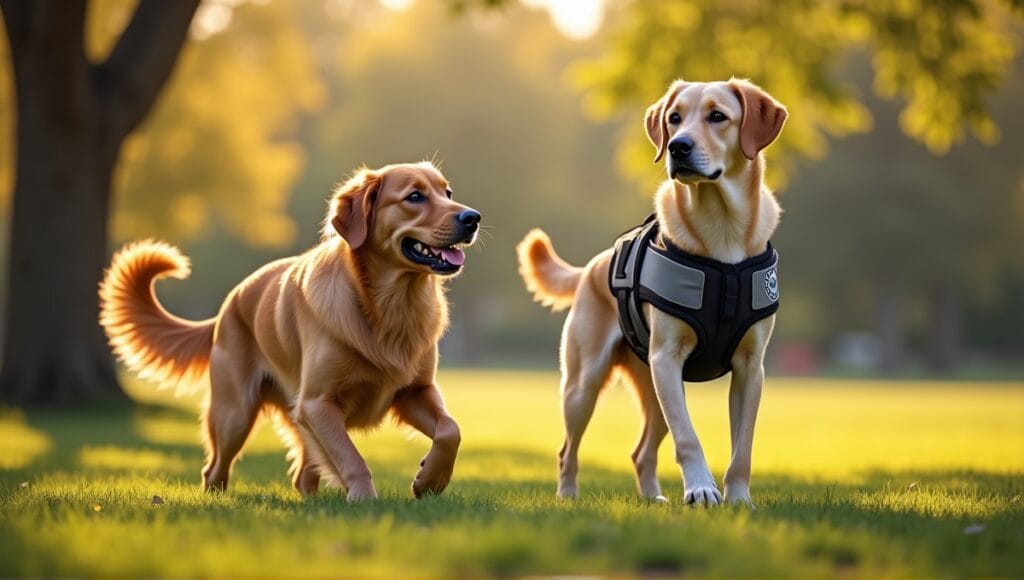Dogs have been man’s best friend for millennia. However, there’s a significant distinction between companion dogs and service dogs. I’ve had the opportunity to work with both, and I can tell you that it’s not just a matter of cuteness. Here’s what differentiates these two types of canine assistants and why it’s important to you and your dog.
Defining Companion Dogs and Service Dogs

Companion dogs are our best friends that provide love and emotional support. These are the dogs you snuggle with on the couch and take for walks in the neighborhood. Service dogs, on the other hand, are on the clock. The Americans with Disabilities Act (ADA) defines service dogs as dogs that are trained to perform specific tasks for people with disabilities.
The key difference is that service dogs work, and companion dogs are just pets. Service dogs have legal protections and public access rights that companion dogs don’t have. Service dogs also go through extensive training to help their handler with daily tasks, or even to alert to medical issues.
Here’s a brief overview of their legal status:
Service dogs:
- Protected by federal law
- Allowed in public places
- No special documentation required
- Cannot be denied housing
Companion dogs:
- No federal protections
- May be restricted in public places
- Subject to housing policies for pets
- No public access rights
I’ve witnessed how both types of dogs can improve people’s lives. However, it’s essential to understand their different purposes and legal rights.
Training Requirements for Service Dogs vs Companion Dogs
Service dog training is rigorous. These dogs are taught very specific, advanced tasks to help their handler with a disability. It takes anywhere from 18-24 months to train a service dog, and the cost ranges from $15,000 to $50,000 per dog. It’s a massive investment of both time and money.
Companion dogs only require basic obedience training and socialization, which includes training the dog to sit, stay, come, and feel comfortable around other people and dogs. Most dog owners can train their dog to be a good companion themselves, or they might attend some basic obedience classes locally to develop a well-behaved pet.
Service dogs must pass a certification test. This ensures they can reliably perform the task their disabled handler needs and that the dog is also well behaved in public. The average pass rate for certification tests for service dogs is around 50-70%, so not every dog is able to do it.
Companion dogs do not need any sort of official certification. However, many enjoy doing some basic obedience training to earn an obedience title or a therapy dog title as a personal goal.
Public Access Rights and Regulations

Service dogs have broad legal privileges. They can go anywhere their handlers go in public. This includes restaurants, shops, and public transportation. Even if a business has a “no pets” policy, they must allow service dogs.
Companion dogs, on the other hand, have many more restrictions. Nearly all public spaces have a “no pets” policy for health and safety reasons. Some dog-friendly establishments may allow companion dogs that behave well, but it’s up to their discretion.
Business owner rights and responsibilities:
- Ask if the dog is a service animal required because of a disability
- Ask if the dog is trained to perform a task
- Cannot ask about the person’s disabilities
- Cannot ask for any identification for the dog
- Can ask the handler to remove the dog if it is out of control or not housebroken
Travel rules are different. Airlines must allow service dogs to fly in the cabin at no charge. Companion dogs may be forced to fly in cargo or pay a pet fee, depending on the airline.
The housing rules come from the Fair Housing Act. Landlords must make reasonable accommodations for service dogs. Companion dogs may be subject to breed or weight restrictions by landlords.
Tasks and Responsibilities of Service Dogs
Service dogs are trained to do a variety of tasks. They can help with mobility by retrieving items, alerting to medical conditions, and even performing household chores or providing deep pressure therapy for anxiety.
The most common service dog breeds and their specialties include:
- Labrador Retrievers: Guide dogs, mobility assistance
- German Shepherds: Police K9s, psychiatric service dogs
- Golden Retrievers: Hearing dogs, seizure alert dogs
- Poodles: Allergy detection, diabetic alert dogs
The medical alerting ability of service dogs is amazing. Some can even predict seizures 45 minutes before they happen, which allows their handler to take precautions and stay safe.
There are an estimated 500,000 service dogs working in the U.S., and each one is a lifeline for their handler, providing them with independence and peace of mind.
Health Benefits of Companion Dogs

Companion dogs provide excellent health benefits. They’re natural stress relievers. Even simply petting a dog can reduce your blood pressure and feelings of anxiety. And it’s not just a sensation – there’s actual scientific evidence to support this.
Spending time with dogs reduces cortisol in the body, which is known as the stress hormone, and simultaneously increases the body’s production of serotonin. Serotonin is a neurotransmitter that acts as a mood stabilizer, promoting feelings of calmness and happiness. Essentially, having a dog is like having an at-home furry therapist.
You’ll also likely be more active as a dog owner. Daily walks and playtime ensure you and your dog stay in good physical shape. And getting in this regular exercise can improve your cardiovascular health and prevent you from becoming overweight.
Companion dogs offer excellent social benefits. Dogs are great conversation starters and can help you make new friends. After all, dog parks and obedience classes are essentially social gathering places for other dog lovers.
Legal Protections for Service Dogs vs Companion Dogs
The ADA has recognized service animals since March 15, 2011. That said, only dogs and miniature horses are considered service animals under federal law.
Service dogs receive strong legal protections. They can go anywhere the general public is allowed and live in housing with their handlers. There’s no official certification required by federal law, though some handlers carry identification cards.
Emotional Support Animals (ESAs) are a bit of a gray area. They’re not considered service animals under the ADA. ESAs have some legal protections in housing, but they don’t have as much legal access in public places as service dogs.
State laws sometimes offer additional protections for service and companion dogs. For example, some states have harsher penalties for interfering with a service animal or denying them access to a public place.
Misrepresenting a pet as a service dog or service animal is illegal in many states. The penalties can include a fine and, in extreme cases, even jail time. It’s important to respect the work of legitimate service dogs.
Cost Comparison: Service Dogs vs Companion Dogs

The cost difference between service dogs and companion canines is significant. Here’s a cost breakdown:
| Expense Category | Service Dogs | Companion Dogs |
|---|---|---|
| Initial Cost | $15,000 – $50,000 | $50 – $500 |
| Training | $10,000 – $30,000 | $100 – $1,000 |
| Annual Healthcare | $1,500 – $2,500 | $700 – $1,500 |
| Food (Annual) | $500 – $1,000 | $300 – $700 |
| Equipment | $500 – $1,000 | $100 – $300 |
| Insurance (Optional) | $300 – $600 | $200 – $500 |
Service dogs require a high upfront investment because most of their cost comes from specialized training. Additionally, they have higher ongoing expenses because they are working dogs and may need specialized care.
Companion dogs have a lower initial investment. However, costs can vary significantly depending on the breed and where you get the dog. Adopting from a shelter is typically the most cost-effective option.
Service dogs can sometimes be difficult to insure. However, some companies offer specific insurance policies for these high-value animals. As for companion dogs, pet insurance is becoming more common and helps to mitigate unexpected veterinary costs.
There are various financial assistance programs designed for those who need service dogs. Some organizations offer fully trained dogs at a reduced cost or even free for qualified individuals. Numerous grants and fundraising options are also available to help offset the cost.
Identifying Service Dogs vs Companion Dogs
Service dogs will often wear a vest or a harness with a sign that they’re a service dog. However, it’s worth noting the ADA doesn’t specify any particular visual indicators. Some handlers carry service dog ID cards, but these aren’t legally required.
The dog’s behavior in public is one visual indicator. The dog will be paying attention to the handler and will be trained to ignore any distractions. In other words, you won’t see a service dog barking at other people or seeking attention.
When you do see a service dog in public, these are a few key tips of etiquette to remember:
- Never distract, pet, or talk to the dog without asking.
- Talk to the handler, not the dog.
- Never offer the dog food or treats.
- Give the dog plenty of space to walk.
A few common misunderstandings about identifying a service dog:
- All service dogs wear a vest.
- The handler has to have the dog certified.
- Only specific breeds can be service dogs.
- You can ask a handler to prove they have a disability and require a service dog.
None of these facts are true. Service dogs come in all shapes and sizes, and the handler isn’t required to show you any proof that they in fact need a service dog.
Impact on Quality of Life: Service Dogs vs Companion Dogs

Service dogs offer significantly increased independence and mobility to their handlers, as they assist with daily tasks the handler would otherwise be unable to do. This increased independence can result in higher self-confidence and overall quality of life.
Companion dogs provide tremendous emotional and social benefits, as they offer companionship and love that helps fight feelings of depression or loneliness. Dog owners also often experience lower stress levels and improved mood.
Both service and companion dog owners typically experience positive long-term health outcomes. Dog ownership increases both physical activity and socialization, both of which contribute to improved cardiovascular health and mental health.
Personal anecdotes and case studies demonstrating the impact:
- Veterans with PTSD who experienced significantly lower symptoms and medication use
- Children with autism who exhibited improved socialization and reduced anxiety
- Elderly individuals who felt considerably less lonely and walked more
- People with mobility issues who felt more comfortable in public)
Historical perspective on service dogs
Service dogs have been helping humans for over a century. Their use became more common after World War I when they were trained as guide dogs for blind veterans. This was the start of the modern service dog era, and they have since been trained to help people with various disabilities.
Choosing Between a Service Dog and a Companion Dog

The decision to get a service dog versus a companion dog is a highly individual decision, as it depends on your unique challenges, lifestyle, and capacity to care for a dog. Here are some things to consider:
- Assess your daily challenges and how a dog could benefit you.
- Think about your living situation and daily schedule.
- Evaluate the financial resources you have available to care for a dog.
- Consider your support system and your capacity to meet a dog’s needs.
If you’re considering a service dog, talk to a healthcare professional. They can help you determine if a service dog is appropriate for your condition and provide the necessary documentation.
Each dog requires a different level of commitment. Service dogs need continued training and care to keep up their skills, while companion dogs require regular training, attention, and exercise throughout their lives.
Where to find reputable organizations:
- Assistance Dogs International (ADI)
- International Association of Assistance Dog Partners (IAADP)
- American Kennel Club (AKC) for breed-specific information
- Local animal shelters and rescue groups
Remember, selecting any dog is a long-term commitment. So take your time and do your research to ensure you make a thoughtful decision that’s right for you and your potential dog.
If you’re looking for a companion dog but aren’t sure which breed would suit you best, consider exploring our guide on best companion dogs. This resource can help you find the perfect match for your lifestyle and preferences.
Closing Remarks
Service dogs and companion dogs serve different purposes in our lives. Service dogs receive specialized training to help people with disabilities, whereas companion dogs provide emotional support and companionship. The legal differences, training qualifications, and public access rights are very different for these two types of dogs. Understanding these distinctions is important for both dog owners and the general public.
You’ve learned about the specific tasks service dogs perform, their legal rights, and the significant investment of time and money their training requires. And while companion dogs don’t receive the same legal recognition as service dogs, they do still provide important emotional support. Just remember to always respect service dogs in public areas, as they are on the job, not just pets.






